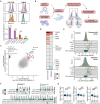Genome-wide CRISPR screen identifies IRF1 and TFAP4 as transcriptional regulators of Galectin-9 in T cell acute lymphoblastic leukemia
- PMID: 40106574
- PMCID: PMC11922064
- DOI: 10.1126/sciadv.ads8351
Genome-wide CRISPR screen identifies IRF1 and TFAP4 as transcriptional regulators of Galectin-9 in T cell acute lymphoblastic leukemia
Abstract
Galectin-9 is overexpressed in a variety of cancers and associated with worse clinical outcome in some cancers. However, the regulators driving Galectin-9 expression are unknown. Here, we defined the transcriptional regulators and epigenetic circuitry of Galectin-9 in pediatric T cell acute lymphoblastic leukemia (T-ALL), as an example of a disease with strong Galectin-9 expression, in which higher expression was associated with lower overall survival. By performing a genome-wide CRISPR screen, we identified the transcription factors IRF1 and TFAP4 as key regulators for Galectin-9 expression by binding its regulatory elements. Whereas IRF1 was observed exclusively on the promoter, TFAP4 binding was detected at an enhancer solely in T-ALL cells associated with higher Galectin-9 levels. Together, our results show that IRF1 is responsible and indispensable for Galectin-9 expression and TFAP4 further fine-tunes its expression. Our approach, a flow-based genome-wide CRISPR screen complemented by transcription factor binding and enhancer mapping, creates innovative opportunities for understanding and manipulating epigenetic transcriptional regulation in cancer.
Figures




Similar articles
-
CRISPR/dCas-mediated counter-silencing: reprogramming dCas proteins into antagonists of xenogeneic silencers.mBio. 2025 Jul 9;16(7):e0038225. doi: 10.1128/mbio.00382-25. Epub 2025 May 28. mBio. 2025. PMID: 40434115 Free PMC article.
-
A targeted CRISPR screen identifies ETS1 as a regulator of HIV-1 latency.PLoS Pathog. 2025 Apr 8;21(4):e1012467. doi: 10.1371/journal.ppat.1012467. eCollection 2025 Apr. PLoS Pathog. 2025. PMID: 40198713 Free PMC article.
-
Galectins-1 and -3 and their ligands in tumor biology. Non-uniform properties in cell-surface presentation and modulation of adhesion to matrix glycoproteins for various tumor cell lines, in biodistribution of free and liposome-bound galectins and in their expression by breast and colorectal carcinomas with/without metastatic propensity.J Cancer Res Clin Oncol. 1999 Aug-Sep;125(8-9):461-74. doi: 10.1007/s004320050303. J Cancer Res Clin Oncol. 1999. PMID: 10480338 Free PMC article.
-
"Galectin-9: A double-edged sword in Acute Myeloid Leukemia".Ann Hematol. 2025 Jun;104(6):3077-3090. doi: 10.1007/s00277-025-06387-x. Ann Hematol. 2025. PMID: 40341460 Free PMC article. Review.
-
Systemic pharmacological treatments for chronic plaque psoriasis: a network meta-analysis.Cochrane Database Syst Rev. 2017 Dec 22;12(12):CD011535. doi: 10.1002/14651858.CD011535.pub2. Cochrane Database Syst Rev. 2017. Update in: Cochrane Database Syst Rev. 2020 Jan 9;1:CD011535. doi: 10.1002/14651858.CD011535.pub3. PMID: 29271481 Free PMC article. Updated.
References
-
- Wada J., Kanwar Y. S., Identification and characterization of Galectin-9, a novel β-galactoside-binding mammalian lectin. J. Biol. Chem. 272, 6078–6086 (1997). - PubMed
-
- Yang R.-Y., Rabinovich G. A., Liu F.-T., Galectins: Structure, function and therapeutic potential. Expert Rev. Mol. Med. 10, e17 (2008). - PubMed
-
- Yang R., Sun L., Li C.-F., Wang Y.-H., Yao J., Li H., Yan M., Chang W.-C., Hsu J.-M., Cha J.-H., Hsu J. L., Chou C.-W., Sun X., Deng Y., Chou C.-K., Yu D., Hung M.-C., Galectin-9 interacts with PD-1 and TIM-3 to regulate T cell death and is a target for cancer immunotherapy. Nat. Commun. 12, 832 (2021). - PMC - PubMed
MeSH terms
Substances
Grants and funding
LinkOut - more resources
Full Text Sources
Research Materials

